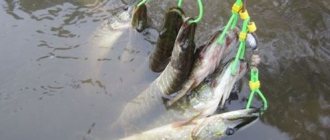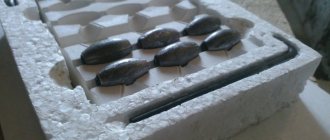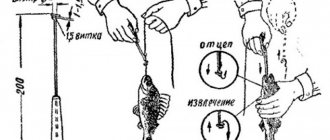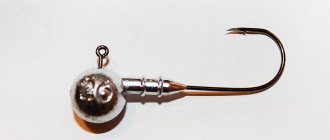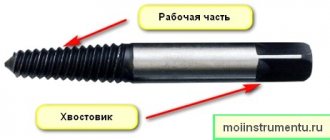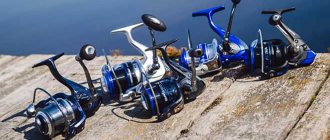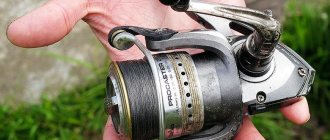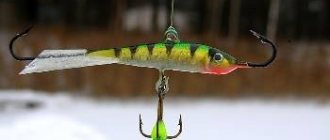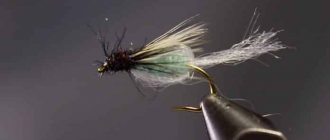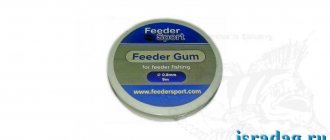What is a crochet hook and how to use it
4 minutes Author: Yuriy Polyakov 7607
Recently, such a device as the hooker has attracted considerable interest in the fishing community. The name of the tool reflects the purpose of its use - it is used for tying hooks.
We also decided to support the topic of conversation and will express our opinion on the necessity and feasibility of this fishing tool. In addition, in our review we will tell you how to use a crochet hook and what modifications they have.
Necessity and feasibility
The fishing hook caused a mixed reaction among fans of fishing. In relation to this tool, fishing enthusiasts can be divided into several categories:
- fishermen who do not know about the existence of the tool;
- ardent supporters of hookworm;
- opponents of adaptation;
- indifferent to the existence of the gadget.
Opponents of the crocheter give the following arguments against its use:
- a self-respecting fisherman should literally tie hooks blindly;
- why waste money on an unnecessary tool;
- learning how to quickly tie hooks with it is quite difficult;
- more fishing line is wasted than with hand knitting.
At the same time, supporters of the gadget put forward their undeniable arguments:
- Tying a hook with a crocheter is quite simple, you just need to practice a few times.
- The tool helps people with reduced visual acuity, especially when crocheting small sizes or in low light.
- The device will be useful for fishermen with impaired fine motor skills of their hands due to some disease or when they freeze during winter fishing.
We believe that the use of a fishing hook for fishing is justified if a person really needs the tool and provides the necessary assistance. At the same time, all the negative opinions of opponents of adaptations for people with certain health impairments should not be decisive.
Types of instruments
Two types of tools are currently used for tying fish hooks: electric and manual.
Necessity and feasibility
The fishing hook caused a mixed reaction among fans of fishing. In relation to this tool, fishing enthusiasts can be divided into several categories:
- fishermen who do not know about the existence of the tool;
- ardent supporters of hookworm;
- opponents of adaptation;
- indifferent to the existence of the gadget.
Opponents of the crocheter give the following arguments against its use:
- a self-respecting fisherman should literally tie hooks blindly;
- why waste money on an unnecessary tool;
- learning how to quickly tie hooks with it is quite difficult;
- more fishing line is wasted than with hand knitting.
At the same time, supporters of the gadget put forward their undeniable arguments:
- Tying a hook with a crocheter is quite simple, you just need to practice a few times.
- The tool helps people with reduced visual acuity, especially when crocheting small sizes or in low light.
- The device will be useful for fishermen with impaired fine motor skills of their hands due to some disease or when they freeze during winter fishing.
We believe that the use of a fishing hook for fishing is justified if a person really needs the tool and provides the necessary assistance. At the same time, all the negative opinions of opponents of adaptations for people with certain health impairments should not be decisive.
Attention! A crochet maker will also be a good help when tying a variety of hooks, for example, when preparing leashes for the new season.
Chinese instrument with brief instructions
Fishing hooker: step-by-step instructions on how to tie a hook
If someone thinks that a fishing hook is superfluous in a fisherman’s equipment, then this will have to be refuted. No, I completely agree that knowing fishing knots and knowing how to tie them are essential skills for an angler. However, circumstances may always arise to acquire an assistant.
Physical data let us down or mutual “love” with small hooks. Doesn't matter. It's time. You can, of course, make crocheting with your own hands. However, I took the easier route. On Aliexpress.
I didn't see a lot of variety of products. On batteries, the mechanism immediately disappeared. You buy it, and then periodically “dive” into the store for batteries. And the simpler the design, the more reliable it is. I took a 3 in 1 set - hook and loop knitting and connecting the two ends of the lines (shock leader with the main one).
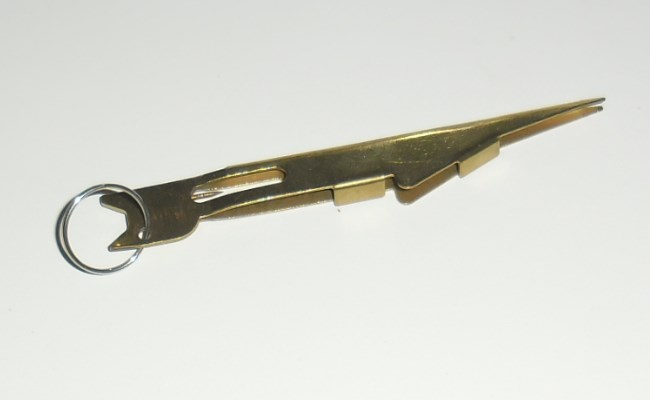
However, the reliability of the latter is questionable. I trust nodes that have been tested in practice. For example, this one.
Let me tell you, it’s an interesting thing, a fishing hook maker. There is nothing complicated in the design. As in use. Step-by-step instructions are included. Once you repeat it three or four times, everything gets stored in your head and hands. The reliability of the node has not yet given rise to doubt.
There’s nothing to shoot a video with yet, but photo manipulations are welcome. In a word, here is step-by-step instructions on how to use all the elements of the set.
How to tie a fishing hook using a hook tie
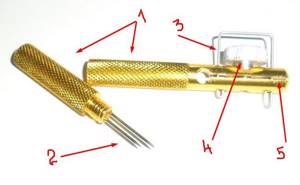
The fishing hook consists of a collapsible metal body, similar to a ballpoint pen, (1).
On one part there is a mechanism for connecting the fishing line with the hook. On the other are two needles of different lengths (2), which are used to create a loop on the fishing line.
The step-by-step instructions are as follows.
Insert the hook into a special slot on the body (5) and tighten it with a screw (4).
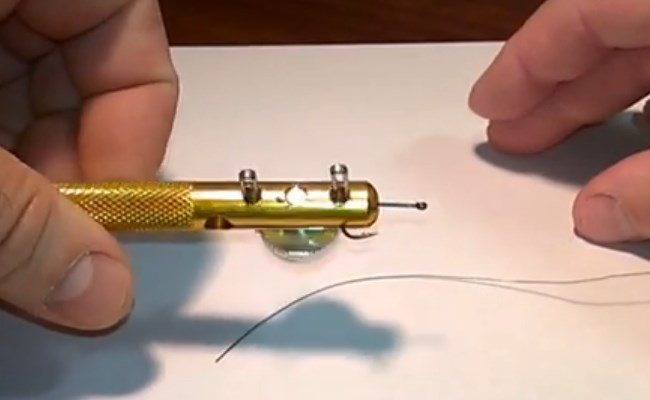
The included instructions indicate that the hook is inserted into the slot with the tip facing inward. Practice has shown that there is not much difference. The sting will stick out from the body or be in it. The point is different. How the fishing line is inserted into the fastening ring of the hook. It’s just that the end result will be that the line will be on the outside or on the inside.
We take the fishing line and thread it into the ring.
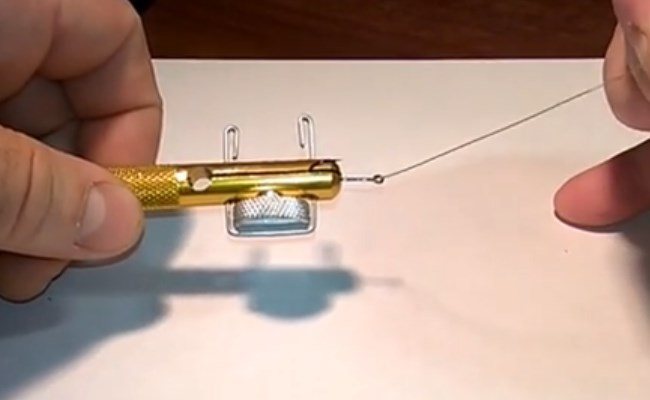
Having passed the fishing line through the ring, we wrap the free end around two clips (3) of the hook and hold it taut. As in the photo.
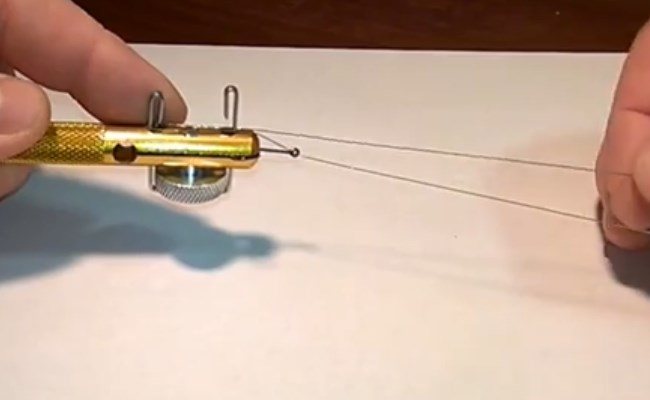
Now, rotating the hook between your fingers, we wrap the fishing line around the fore-end. 5 - 7 full turns are enough.
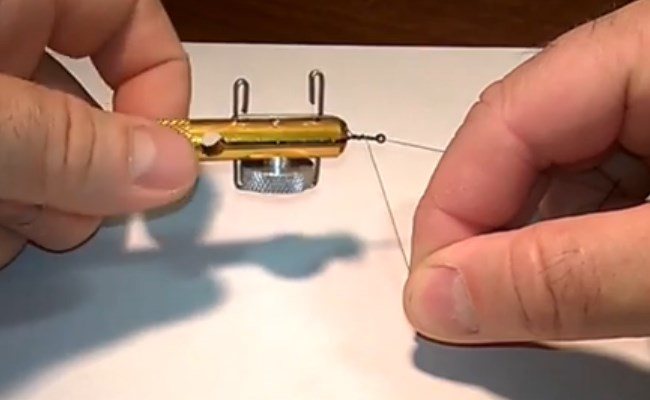
Throw the free end of the fishing line through the hook clip closest to the edge.
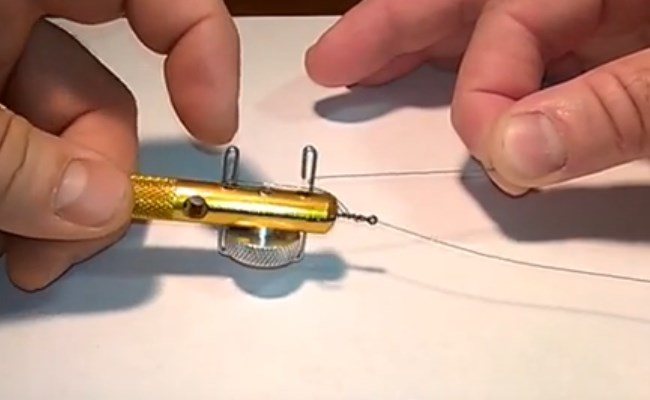
We completely recess both clips into the body and carefully pull the length of the leash.
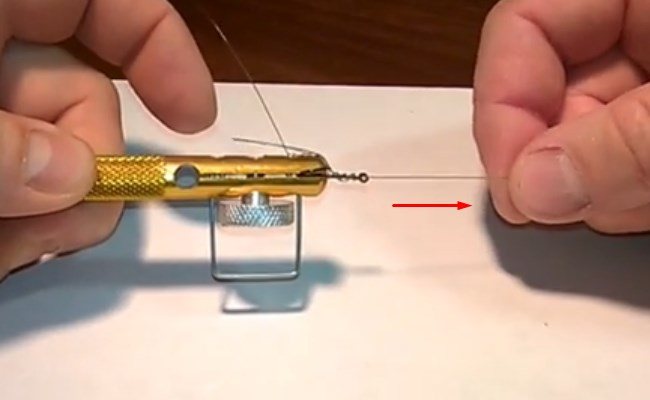
When the loops around the fore-end are formed, loosen the grip of the hook with the screw and continue to pull out the fishing line. The hook is then released.
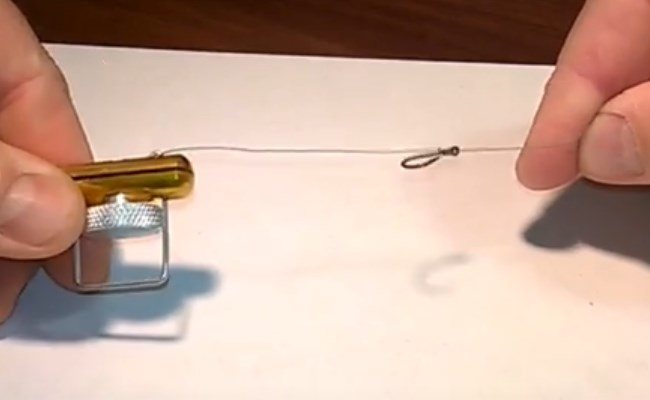
We wet the resulting joint and tighten it with force. Trim off the excess end of the fishing line.
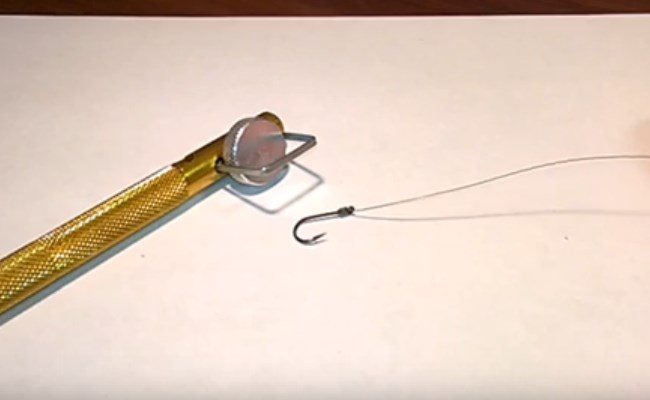
Now let’s give the leash its final look - we’ll form a fastening loop.
A hook with a spade is tied in the same manner, where there is no step of threading the fishing line through the ring.
Fishing looper, photo diagram of use
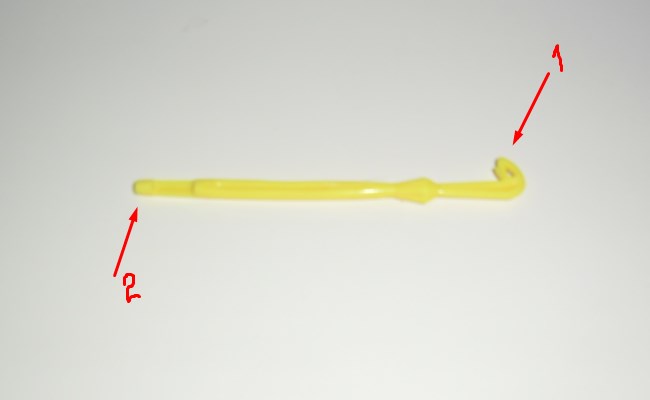
The looper in our case is represented by a plastic device. On the one hand (1) there is a looper directly. On the other, there is an extractor (2) to release the hook from the mouth of the caught fish. Color and size varies.
Using the device is as easy as using a crochet hook.
We take the fishing line and create such a loop.
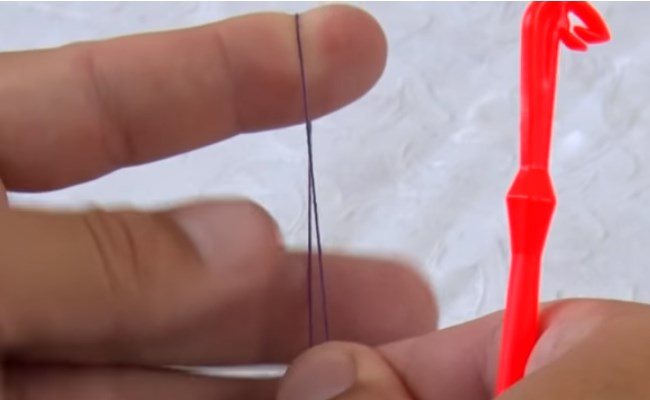
We hook the folded fishing line with the tooth of a looper.
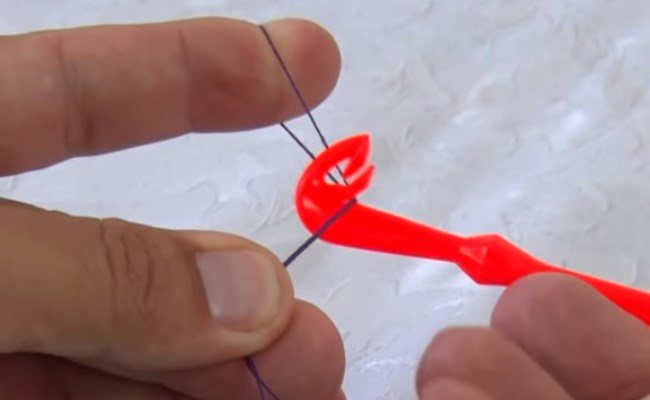
Make 2 - 3 turns with a looper, twisting the line
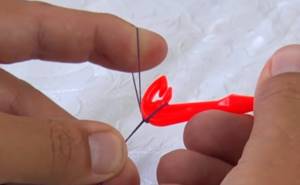
Without removing the loop from your finger, we put it on the looper hook.
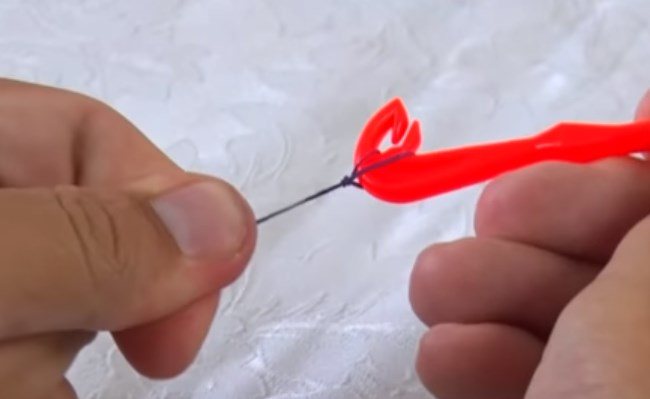
Now, with the movement of our hands, we remove the turn of the fishing line from the looper tooth. In this case, the formed loop remains on the inner hook.
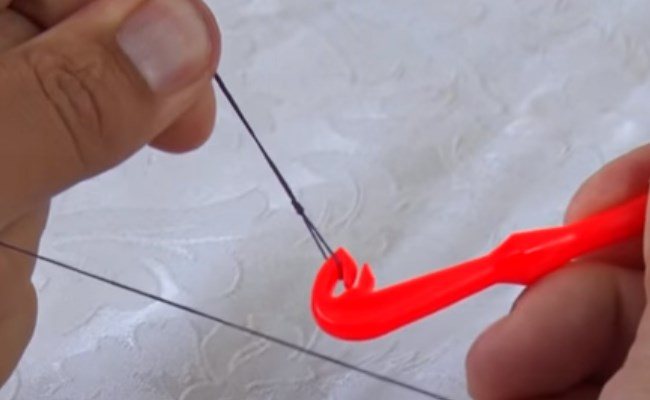
We remove the loop, trim off the excess and that’s it. As a result of the simple work of a fishing hook, looper and your hands, we get approximately this type of leash.
How to tie fishing line to a hook without an eye
Hooks without an eye are a special type of fishing hook; such hooks have a special blade instead of a ring for tying fishing line. Beginner fishermen most often avoid hooks with a spatula instead of an eye, because it seems to them that when tying a fishing line to such a hook, the connection between the fishing line and the hook will not be strong and reliable. In fact, tying a hook without an eye is no more difficult than a regular hook, and if you use the right type of knot, the connection will be no less strong and reliable than that of a hook with an eye.
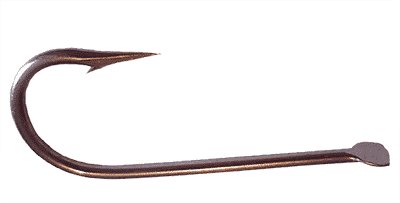
When using hooks with a spatula instead of an eye, there are a number of nuances to their use:
- The spade hook is better suited for catching wary fish where a neat presentation of the bait to the fish is required.
- The knot of the hooks with the spatula is placed on the fore-end and therefore turns out to be more compact.
- When tying a hook without an eye to a fishing line, the shank of the hook and the fishing line are positioned in a straight line.
- It is better not to use hooks with a spatula when catching strong fish; when the fish jerks, the knot can slip and become damaged, which will lead to the loss of the trophy.
- It is easier to tie a knot on a small hook; if it is a hook with a spade, the angler will not have to thread the line through a very small eye.
- The numbering of the sizes of hooks with a blade completely corresponds to the numbering of the sizes of ordinary hooks with an eye.
- Hooks without an eye of the right size and shape are much more difficult to find on sale.
- When buying hooks in a store, you should choose only high-quality hooks from well-known companies.
Step knot
A step knot is designed for tying fishing line to a hook without an eye. The strength of the knot is 90-95%. The knot is well suited for monofilament and fluorocarbon fishing line, but slightly less suitable for braided fishing line. Doesn't work well with very thick lines.
To tie a fishing line to a hook using a step knot, do the following:
- Fold the free end of the fishing line along the shank of the hook to form a loop
- We make 2 turns around the shank of the hook and one side of the loop, placing the turns from top to bottom towards the bend of the hook
- Then we make another 3-5 turns around the shank of the hook and both sides of the loop
- We thread the end of the fishing line through the loop and tighten it
Spiral Dumhof knot
The simplest knot for attaching fishing line to a hook with a spatula. It is better suited for large hooks; it is more difficult to perform on small hooks with a short shank. The strength of the Dumhof knot is 75-80% of the breaking strength of the fishing line.
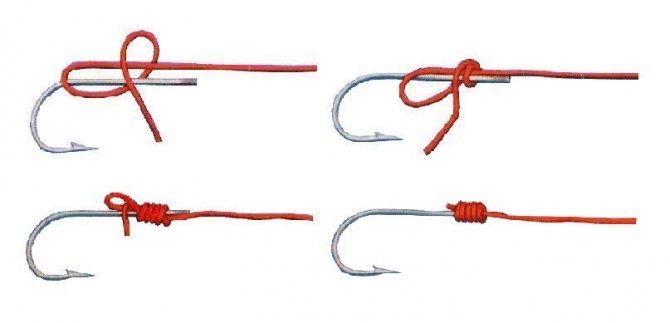
To tie a fishing line to a hook using a Dumhof knot, do the following:
- Form a loop on the fishing line and attach it to the shank of the hook.
- Make 4-7 turns with the free end of the fishing line around the loop and fore-end, moving along the fore-end towards the bend of the hook, lay the turns one to one so that they do not creep on each other and do not overlap.
- Thread the free end of the fishing line through the loop, slide the knot toward the blade of the hook, wet the fishing line and tighten the knot tightly.
Snell node
The Snell knot can be used with either a hook without an eye or to tie several hooks with an eye to one leader. The strength of the Snell knot is 90% of the breaking strength of the fishing line.
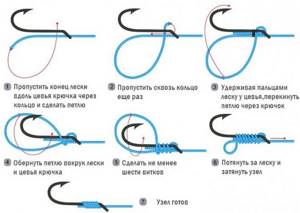
To tie a fishing line to a hook using a Snell knot, do the following:
- Make a large loop at the end of the line, which should flow freely over the bend of the hook.
- Make 7-8 turns of the loop around the shank of the hook, the size of the loop will decrease with each turn.
- Slide the knot along the fore-end towards the blade, wet the line and finally tighten the knot, holding both ends of the line.
How to choose a crochet hook
Crocheting is a very interesting activity. And versatile! Crocheting involves more techniques than knitting: after all, you can crochet both a straight fabric and a circle, and what kind of openwork patterns you get - a sight for sore eyes! Meanwhile, the beauty of the final result depends not only on the skill of the knitter, but also on the choice of hook. Choosing the right crochet hook is very important. If the hook is chosen incorrectly, the fabric will turn out stretched, crooked, or, on the contrary, too rigid and tight.
Structure of a crochet hook
But before we start learning how to select a hook for yarn, we need to understand the appearance of the hook. The base of the hook, its handle, is called the shank. An end with a hook - a head. And the hooking, working part of the hook is the barb.
When choosing a hook, always pay attention to the sharpness of its head. If it's too sharp, you risk cutting your fingers when knitting. But a head that is too round is also not good: it is difficult to knit with such a crochet hook, it is difficult to insert it into the loops. What kind of head should the hook have? Ideally - in the form of a rounded cone.
Are hooks with handles convenient? Only for those who have been knitting for a long time. For a beginner knitter, such a hook is hardly suitable. Since your handwriting in this art form has not yet developed, you need to feel whether you are pulling the loop tightly or weakly. And the knob reduces sensitivity.
What are the best crochet hooks: select the hook according to the material
However, it is not only the structure of the hook that makes the choice difficult. The store has all kinds of hooks: here you can find wood, plastic, and metal! How do they differ from each other? And what are the best crochet hooks?
Steel hooks are the most practical and convenient. They last a long time and can be used for any yarn.
Aluminum hooks are also comfortable, and what’s nice when knitting for a long time is that they are very light. Although they also have disadvantages: they often stain light-colored knitting, the fingers of the craftswoman, and if the knitting is too hard, such a hook can even bend.
Plastic hooks are cheap, light and very convenient, they do not hurt your fingers. They have only one drawback - they can electrify the yarn. But if you like the plastic hook, just spray it with an antistatic agent to remove this drawback. Important: when choosing a plastic crochet hook, you need to make sure that it is not too flexible.
Wooden hooks are very beautiful, light and environmentally friendly. But they are not very practical: they become electrified and quickly become covered with burrs, which catch the thread and interfere with knitting.
Bone hooks are an ideal option for knitting from natural wool. But these hooks are quite expensive, and also fragile.
How to choose a hook for yarn?
But neither the material, nor even a comfortable hook head has as much influence on the beauty of your knitting as the correct choice of hook for the yarn. You can see for yourself: there are thin hooks, and there are thick ones. It is clear that thick yarn requires a thick hook, but which one?
How to choose the right crochet hook for beginners? The easiest way is to use the manufacturer's hint. Typically, on skeins of yarn, manufacturers indicate which hook and needle numbers are suitable for each specific yarn. But what if there is no such indication? Then what should we do?
And in this case, there is a simple method that is suitable for a beginning craftswoman. All you need is your hooks and the thread you like. Hook the thread and watch carefully.
If the thread is easily picked up by the hook, and the barb protrudes above the thread, then the hook is too thick. If the beard is not visible at all because of the thread, the hook is too thin. Which hook is suitable? The one whose beard will be flush with the thread when hooked.
If you don't have the opportunity to carry all your hooks with you, you can simply remember their numbers and rely on the method of measurement. The fact is that the hook number is the thickness of its working part. That is, hook No. 2 has a working part thickness of 2 mm. Experienced craftswomen believe that the thickness of the yarn should be 1 mm less than the thickness of the hook - in this case, the knitting will be even and beautiful.
But what about an online store? If you want to buy a crochet hook online, store managers will always help you. Knowledge about the features of choosing crochet hooks, as well as professional advice from consultants, will help you choose the ideal hook for your work.
On our website you can also read about the selection and types of yarn for knitting.
How to tie fishing hooks video. How to tie a hook to a fishing line
If someone thinks that a fishing hook is superfluous in a fisherman’s equipment, then this will have to be refuted. No, I completely agree that knowing fishing knots and knowing how to tie them are essential skills for an angler. However, circumstances may always arise to acquire an assistant. Physical data let us down or mutual “love” with small hooks. Doesn't matter. It's time. You can, of course, make crocheting with your own hands. However, I took the easier route. On Aliexpress.
I didn't see a lot of variety of products. On batteries, the mechanism immediately disappeared. You buy it, and then periodically “dive” into the store for batteries. And the simpler the design, the more reliable it is. I took a 3 in 1 set - hook and loop knitting and connecting the two ends of the lines (shock leader with the main one).
However, the reliability of the latter is questionable. I trust nodes that have been tested in practice. For example, this one.
So.
Let me tell you, it’s an interesting thing, a fishing hook maker. There is nothing complicated in the design. As in use. Step-by-step instructions are included. Once you repeat it three or four times, everything gets stored in your head and hands. The reliability of the node has not yet given rise to doubt.
There’s nothing to shoot a video with yet, but photo manipulations are welcome. In a word, here is step-by-step instructions on how to use all the elements of the set.
How to tie a fishing hook using a hook tie
The fishing hook consists of a collapsible metal body, similar to a ballpoint pen, (1).
Types of offset hooks, tips for choosing
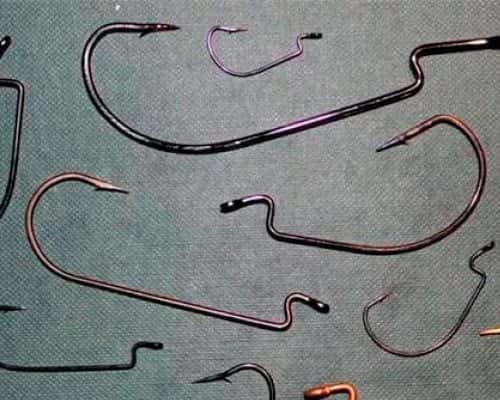
In the first half of the 20th century, somewhere in the southern states of the USA, a hook of a specific shape called the Offset hook was invented. Experimental fishermen constantly come up with a large number of ideas related to the refinement and improvement of one or another element of equipment. Most of them go unnoticed, but the offset hook belongs to a different category. The invention of this hook gave impetus to the creation of a whole range of fundamentally new baits and equipment that do not get caught even in dense thickets.
Design Features
The creation of these hooks was driven by the need to protect the bait from snagging, but at the same time reliably detect fish. And this was done with just minor changes in shape. Visually, offset printers have two features. • The first is a sting that fits tightly to the surface of the bait or is located in a special groove. • The second is a characteristic Z-shaped bend in the front part of the hook near the ring. If you delve further, you will find that the Z-shaped bend may differ.
In one case, the step consists of two bends at right angles, and in others - at a sharper angle. At a first glance, this doesn't look like much of a difference. However, the second option is still preferable, since the bait on a steep step is better fixed and therefore slips less often.
In addition to the step, offset machines differ in the shape of the bend.
Texas Hook
The classic Texas hook offset press has a straight bend. A more modern option is a Wide gap hook with a wide bend. The advantage of the latter is the larger space between the belly of the bait and the fore-end. This is very important in cases where the plastic is not soft enough. In this case, a large gap allows the fish to push the bait harder and hook with a greater guarantee.
Wide Gap
Among the Wide Gap type offsets, there are two modifications: for high baits and narrow ones. The difference between them is that in the hook for narrow baits the sting looks strictly at the fore-end, and for wide ones - slightly higher.
Sickle Hook
The third form of hook - Sickle Hook - appeared relatively recently. Moreover, at first these hooks with a characteristic crescent-shaped bend were common in jig heads. The main motivation is that, firstly, the rubber sits much more securely on such a bend and does not slip. This is especially true in cases where you have to fish with a heavy load over long distances. Secondly, thanks to this shape, during a bite, the hook spontaneously sticks into the side of the fish’s mouth. And thirdly, such a hook holds hooked fish more reliably during fishing.
Installation methods
Using an offset hook involves mounting the bait on it according to the non-hooking principle. However, there are two varieties of non-snacking mounts. • The first is traditional Texas . It requires a regular offset hook with a straight bend. First, the bait is pierced in the head part and fixed on a Z-shaped step. The sting is inserted into the body almost completely, but does not come out. Thus, the bait is maximally protected from snags. For this installation, it is very important to monitor the sharpness of the hook so that during hooking it can not only pierce the silicone, but also hook the fish. • The second installation is called open , and wide gap offset printers are used here. In this case, the hook tip is pressed tightly against the surface of the bait or hidden in a special groove. Strictly speaking, this installation is conventionally called open, since the tightly pressed tip does not catch the grass. If we are talking about classic jig fishing, then the hook with the eared weight is connected through a winding ring. You should not use fasteners for this, as they are not always reliable. There are situations when the offset eye is too small and the ring does not fit there. In this case, you need to bite off a third of the turn or a little more from the ring with side cutters. There are also collapsible Cheburashkas, but if we are talking about catching large fish or the need for forced fishing, you need to choose such loads carefully, since some of them use insufficiently high-quality wire.
In addition to conventional offset machines, there are also loaded ones. The difference between them is that a certain amount of lead is soldered onto the forend. In most cases, these offset baits come in a wide gap design and are designed primarily for use with soft jerkbaits or swimbaits. Such hooks do not require additional weight, as they are designed for spot fishing in grass or snags, where a long casting distance is not required. Offset hooks have firmly taken their place in jig fishing. And to some extent, they replaced outdated jig heads even from ultralight. This suggests that offset printers open up great opportunities in the installation of baits, areas of application and, most importantly, in scales. After all, it is very difficult to find a jig head weighing, say, 10 grams, the hook of which would fit an inch twister.
How to choose a crochet hook

Almost everyone who is just starting to learn to knit does not read articles about choosing a tool. And most likely they do it unconsciously, wanting to start creating knitted masterpieces faster...
Understanding the importance of choosing a hook comes when, having been tormented with a simple pattern, we do not even see the semblance of a beautiful picture, and after much effort our fingers are worn out by an incorrectly selected tool. Frustrated beginners put their work on the back burner and risk never getting to know such an exciting activity as crocheting. It is important to immediately understand that the correct choice of tools and yarn is a guarantee of a successful result. Both the quality of the product and the efficiency of our work depend on it. Therefore, it is very important to approach the choice of a hook no less diligently than the selection of materials for knitting and the style of the product.
So, how to choose a crochet hook ?
To choose the right hook, you need to study its structure in more detail.
In terms of length, there are short hooks (12-16 cm) for regular knitting and long hooks (20-40 cm) for Tunisian knitting. The hook consists of several parts. Let's consider the purpose of each of them.
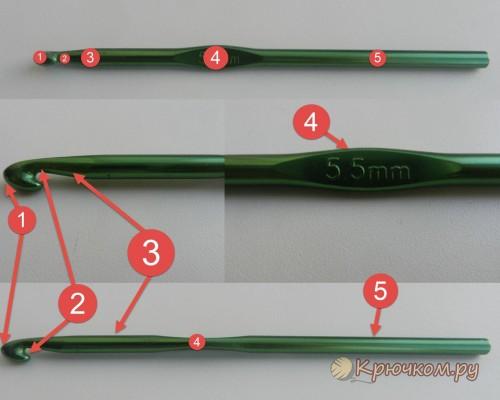
- The head is the rounded tip of the hook. It should be sharp, but not too sharp, so as not to injure the working finger or split the yarn.
- The narrowest part of the hook is the notch. It is this part of the hook that helps to hook and pull the thread into the loop.
- The rod or working part forms the size of the loop and determines the knitting density. The size of the hook is determined by its diameter. If you cannot determine the size, then you just need to measure the diameter of its rod.
- The flat part on the hook is needed to support the thumb and index finger, sometimes called "cheeks". The hook size is indicated on it in numbers from 0.4 mm to 10 mm, but sometimes it is also indicated on the handle. On some models, this part is missing.
- And the last part of the hook is the handle. Handles are made from different materials: wood, plastic, etc., but if you are just learning to knit, it is better to take a hook made of the same material as the handle, so that your hand can feel the tension level of the thread.
There are hooks - metal, aluminum, plastic, combined, and each has its own advantages.
Offset hook - a remedy for snags
The shape and principle of operation of the offset hook
An offset hook is one of the varieties of a fishing hook that has a special shape with a characteristic Z-shaped bend of the forend (step) at its base. It was invented in the first half of the twentieth century, but since then it has been constantly improved, undergoing changes for the better.
Basically, offset hooks are used in spinning equipment together with soft baits made of silicone and foam rubber. To attach them to the offset machine, a special installation is used, in which the surface of the bait fits tightly to the tip of the hook, covering its piercing part and protecting it from snagging on the grass and surrounding objects.
This kind of installation is called non-snacking, and the baits themselves mounted on offset hooks in a similar way are called “non-snacking”. Unhooked baits can pass through thickets of vegetation and littered areas of the bottom; they are used to catch snags and wetlands, where baits with open hooks and tees have no chance of getting out of the water without getting caught on grass or snags.
After proper installation, the vertical segment of the Z-shaped elbow should be located across the body of the bait, 5 - 6 mm from its beginning, preventing it from sliding off the hook and twisting.
When a predatory fish attacks a silicone product, grabbing and squeezing it with its teeth, the soft bait sags under the pressure of its jaws, exposing the sting of the hook (for this, there must be free space on the hook), and the fisherman’s timely hooking drives it into the victim’s mouth.
The e-book “Fishing for Beginners” will answer all your questions and will be the best assistant in mastering this activity. More details
Types of offset hooks and their applications
The shapes of offset presses can be different. Their difference lies directly in the nature of the bend of the hook and the configuration of the Z-shaped step:
- Classic Texas hook type hooks were the very first to appear on the domestic fishing market and have some restrictions for baits used together. A straight forend with a clear rectangular elbow at the beginning of its base allows you to use only narrow - long-bodied lures in tandem, which work when there is very little clearance underneath. Such baits include silicone worms, slugs, thin vibrating tails and twisters, which are also used with other types of offset hooks. The hardness of the material from which they are made also affects fishing results. For example, soft edible rubber does not require much effort from the fish's jaws to expose the hook, unlike hard latex, and increases the angler's chances of a good catch.
- W-shaped hooks >In addition, there are options for weighted hooks, with a special lead load installed on them. Spinning rods are equipped with such heavy hooks when it is necessary to cast bait over a long distance, for fishing in thickets or snags at a distance from the shore.
You can provide the hook with additional weight yourself by winding lead or tin wire around its body, or by attaching a separate “eared” sinker to it, popularly nicknamed “Cheburashka” because of the two fastening loops located on opposite sides of the lead ball, reminiscent of the ears on the head of Cheburashka, the main character of the famous Soviet cartoon: “Cheburashka and the Crocodile Gena.” For one of them, the sinker is attached to the hook using a winding ring, for the other, it is fastened to a carabiner coming from the main fishing line. This type of installation of a sinker with an offset hook is called hinged and is most often used to weight a hook with bait.
The movable connection of the sinker has a positive effect on the game of the bait, providing it with more natural behavior. For this reason, offset hooks with Cheburashka give better results than jig heads - hooks with a cast lead head.
Offset hook size and criteria for its selection
Offset hooks are measured against baits and selected strictly according to their sizes. If the hook size is insufficient for a particular rubber bait, then there will be no clearance between it and the shank of the hook, which is why the piercing end of the hook will not be able to expose itself and hook the fish.
If a rubber vibrating tail or twister is correctly installed on a hook of a suitable size, there should be a decent gap left on its hook - free space, almost the same as the height of the bait. This will allow the fish to bite the artificial bait well and hook easily.
To do this, before selecting and installing offset hooks, they must be tried on for the baits with which they will be used, taking into account their length, height, and paying attention to the hardness of the silicone. Preference is given to material of medium hardness, and in some cases even hard, which prolongs the life of polymer imitations, but requires larger hooks.
In order not to resort to using bulky hooks that do not fit into the fish’s mouth, you can string wide-bodied baits from the side. This will not affect their game in any way, but on the contrary, it will increase their attractiveness. A synthetic fake floating on its side will really look like a wounded or sick fish.
Soft baits made of edible rubber have a limited service life, which often ends on the very first fishing trip, after encountering the sharp teeth of a predator. They are not stable on the hook, slip, twist and often break during use. They can confidently be considered not just consumables, but very quickly consumed raw materials, which does not in any way affect their price.
When trying on, pay attention to the length of the hook; it should not pierce parts of the bait’s body intended for active movements in the water. Otherwise, they will be rigidly attached to the hook and lose mobility, and the bait itself will not be able to play because of this.
In addition, the thickness of the wire from which the offset machine is made and the breaking load of the fishing line with which it will be used matters. Thin offset notches used with strong braided cords can be pulled off the hooks without any problems. As soon as they straighten up under the tension of the fishing line, they immediately release their chosen ones, and upon arrival at the shore, they are restored to their original appearance with the help of pliers. This option is suitable for catching small pike perch or pike perch. Among other things, thin-bodied accessories are more grippy - they penetrate the mouth of any fish well. But for catching pike, large pike perch and asp, you should use thicker metal, which will hold strong fish without bending under its jerks and shaking.
For hard silicone and latex, as well as baits with a wide body, it is better to use hooks with a steeply curved forearm - such as Wide Gap or Sickle Hook.
For non-hooking installation, when attaching the bait to the iron, it is important that the tip of the hook fits tightly to it or is hidden in a slot specially made in its body. Otherwise, the non-hooking effect will disappear, although offset workers often use it with an open tip, like regular hooks.
All offset hooks are of high quality, as they are made of carbon steel, which has increased strength and keeps the tip sharp for a long time. To prevent corrosion processes, products must be coated with protective compounds or blued.
With a lot of advantages, offset-type hooks have some disadvantages, which include their high cost, frequent idle bites and systematic fish disappearances. This is explained by the fact that the effectiveness of the hook largely depends on its position in the predator’s mouth and the force squeezing it. And since the fish attacks the bait from different angles, not always squeezing it in the place where it needs to be done and with the force that is required of it, the offset hook does not work.
The tee is a different matter; as soon as it gets into the victim’s mouth or even gets close to her, it will inevitably dig into the poor fellow’s body. But it just as successfully catches the objects around it, making no exception even for the fishermen themselves.
It is more advisable to use non-hooking baits where others - alternative baits with open hooks cannot be used or they do not give positive results.
Best wishes. Good luck fishing.
The video will help you correctly mount the silicone bait on an offset hook.
